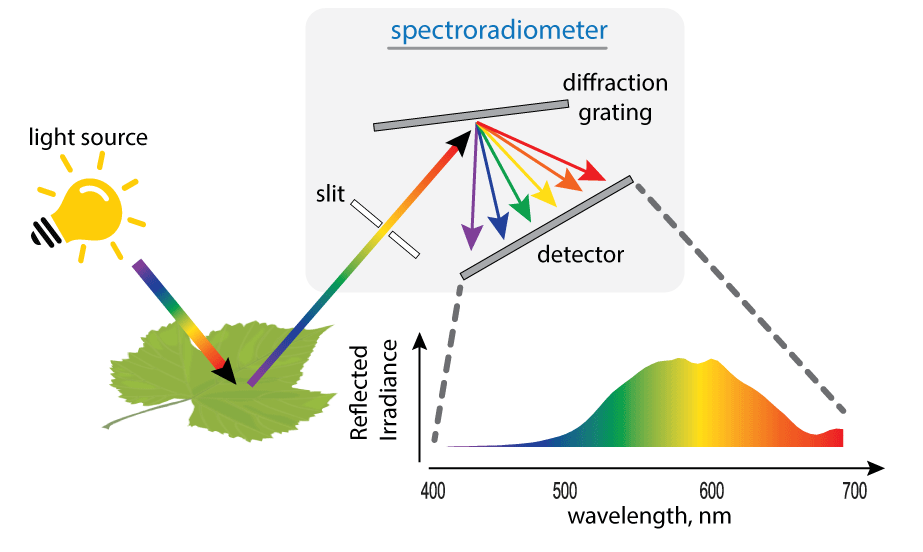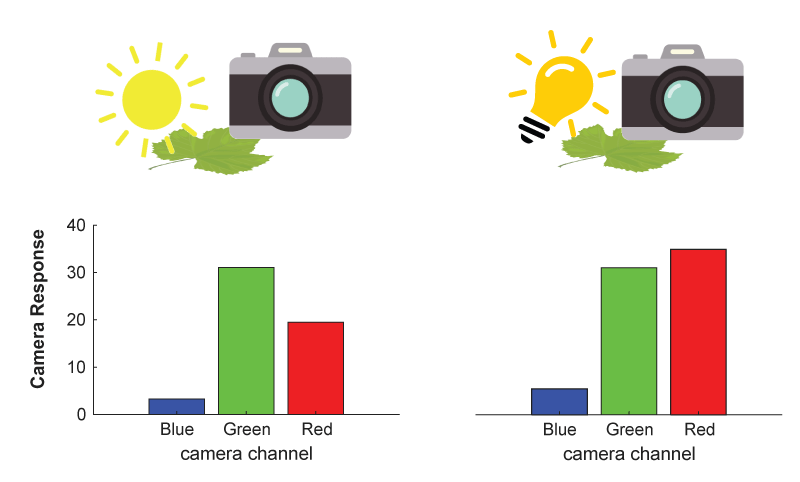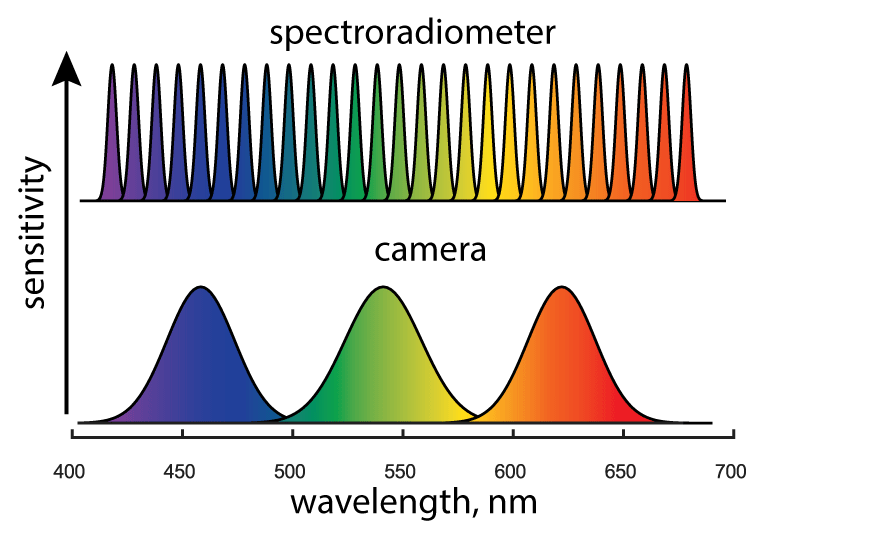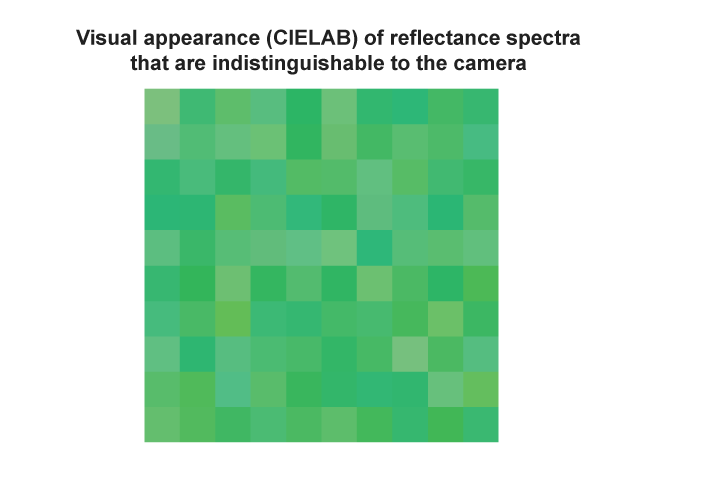Spectral Reflectance and Colour
A reflectance spectrum describes how much light an object reflects at different wavelengths. This spectral signature can reveal important information about the object’s composition, as different materials absorb and reflect light in characteristic ways. The reflectance spectrum also substantially influences the perceived colour of an object, meaning that measuring colour can indirectly provide insights into material composition.

For example, the reflectance spectra of rice leaves shown above compare a plant grown under normal conditions with one grown in nitrogen-deficient soil. The healthier leaf appears darker and greener, while the nitrogen-deficient leaf looks yellower. This difference arises because the deficient leaf reflects more light overall—and particularly more at longer (red) wavelengths. This is due to reduced chlorophyll content. Nitrogen is essential for chlorophyll production, so its absence limits the plant’s ability to synthesise this key photosynthetic pigment.
Since chlorophyll is vital for photosynthesis and growth, changes in leaf colour can signal plant stress. Detecting these changes allows farmers to make informed decisions—such as adjusting nitrogen fertiliser application—to improve crop health and yield.
Measuring Colour & Spectral Reflectance
Traditionally, colour and spectral reflectance are measured using specialised instruments like colorimeters or spectroradiometers that precisely characterise the relative amount of light reflected by a surface. Spectroradiometers often employ diffraction gratings which spread out light according to wavelength and combined with controlled light sources these enable calibrated repeatable measurements over narrow wavelength bands (often less than 1nm).

Using Cameras to Measure Spectral Reflectance
Problem 1. Same Stimulus, Different Response
In contrast, digital cameras are not primarily designed for scientific measurement. Their sensors respond to broad wavelength ranges - similar to human vision - but their sensitivity varies between models and brands.

As a result, the same object photographed with different cameras under the same lighting conditions may produce unique colour signals.

Additionally, camera output depends heavily on illumination. Natural sunlight and artificial light sources have different spectral compositions, so the same scene under different lighting can yield very different RGB values - even when captured with the same camera.

Using Cameras to Measure Spectral Reflectance
Problem 2. Loss of Spectral Detail
Moreover, cameras are optimised to produce aesthetically appealing images. Image processing algorithms enhance contrast, saturation, and use white balance to produce visually pleasing photos, often at the expense of faithful colour representation. The three images of the Mona Lisa below illustrate how dramatically colour can vary across digital reproductions of the same artwork.

Unlike spectroradiometers, which resolve fine details in the reflectance spectrum through many wavelength-sensitive channels, digital cameras collapse spectral information into just three broad overlapping channels (red, green, blue). This leads to a significant loss of detail, particularly for subtle or localised spectral features and colour differences.

As a result, many different reflectance spectra can produce the same RGB signal - a phenomenon known as metamerism. The image below shows 100 distinct simulated spectra that yield the same RGB signal i.e. they would appear identical to a camera with the spectral sensitivities shown below. This "many-to-one" mapping makes it impossible to uniquely reconstruct a full reflectance spectrum from an RGB value in the general case.

The colour appearance of the 100 different reflectance spectra are shown on the mosaic below. Despite the obvious differences in colour that would be perceived by a human observer, a camera with the spectral sensitivities above, operating under daylight conditions, would produce the same RGB signal and not be able to discriminate any of the surfaces associated with these patches.

When Accurate Spectral Estimation Using Cameras is Possible
In the above example, the camera-metameric spectra are free to vary in complex ways as long as they produce the same camera output. In many practical situations, however, the variation in spectral reflectance is constrained by a small number of underlying factors. For instance, human skin reflectance is primarily shaped by two pigments: haemoglobin, which creates a characteristic "W"-shaped absorption pattern in the green to red region, and melanin, which influences the overall slope and scale of the curve. While other factors contribute, these two dominate the spectral curve.
When we simulate how a camera responds to a series of skin spectra, each spectrum produces a unique RGB value. This one-to-one relationship between reflectance spectrum and camera response means that, under controlled assumptions, it is in principle, possible to estimate spectral reflectance from a digital image of skin because the camera can discriminate the different skin reflectance spectra.

The Science Behind ColourWorker
This insight forms the foundation of ColourWorker and apps like PhotoFolia. When the spectral variation in a material can be described by three or fewer independent factors, and the camera’s spectral channels are sensitive to those variations, accurate estimation of colour and reflectance becomes feasible.
ColourWorker uses a two-stage calibration process:
-
Camera and Illumination Modelling:
First, the system measures the camera’s response to a cardboard standard containing coloured patches of known spectral reflectance. This allows ColourWorker to model the combined effects of the camera’s spectral sensitivity and the ambient lighting, enabling accurate measurements under real-world, uncontrolled conditions.
-
Material-Specific Prediction:
Using this model, ColourWorker predicts how the camera would respond to reflectance spectra representative of a specific material class—such as leaves, skin, fabric, fruit etc. These predictions are used to build a second model that translates the actual camera RGB values produced in response to the subject material into meaningful outputs, such as:
- Spectral reflectance
- Objective colour values
- Biologically relevant metrics (e.g., leaf chlorophyll concentration)
By combining physical modelling with material-specific spectral knowledge, ColourWorker transforms everyday digital cameras into powerful tools for objective, quantitative analysis.
